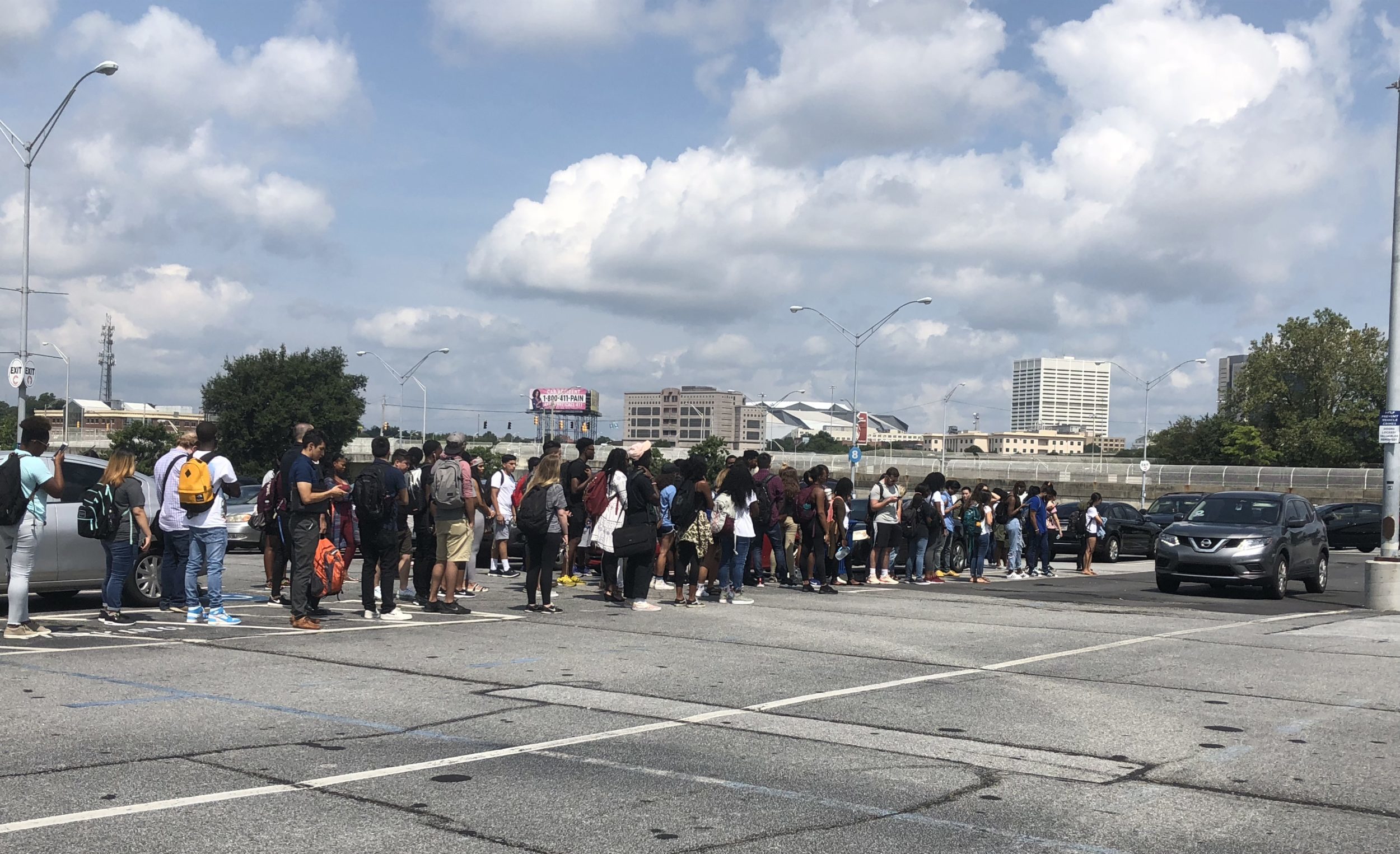
On Monday, Sept. 17, the Georgia State parking and transportation department introduced a line system at the Blue Lot in response to a large number of student complaints about the overcrowding at pick-up and drop-off sites.
“I shouldn’t have to fight to get on a bus,” Georgia State student Sandra Mencia said. “Sometimes four buses will come before I can actually get on one, even if I was there first because people push in front of me.”
The Georgia State parking and transportation department issued a press release that explained the reasons behind the congestion.
“The Transportation Office and Campus Services understands student frustrations with regard to Panther Express bus delays during the Courtland Street Bridge construction project and we are working to improve your Blue Lot parking experience,” the press release stated.
Because of student volume and crowding issues at the stadium, they have designated separate bus pick-up and drop-off areas.
“Barricades have been installed to create a better flow for entering the buses. We will have supervisors monitoring during peak times to ensure that the pick-up line maintains order,” Alfred C. Austin IV, the director of parking and transportation, said.
Aside from the new line system, the department also added an additional bus on the Blue Route to the stadium and up to three buses are being added to the route during peak times to address high volume demands.
Atlanta traffic remains the biggest obstacle, as peak times can severely delay buses.
“Because the buses have to take longer routes in heavier traffic during the [Courtland Street Bridge project] and manage increased student volume this fall, the Transportation Office has implemented plans to keep the buses running as smoothly as possible,” Austin said.
The press release stated, “A Georgia State police officer has been stationed at the stadium parking lot near the pick-up area. In addition, the Transportation Office is working closely with the GSU Police to help clear congested traffic areas.”
“The transportation office is monitoring the traffic along the blue route and student volume at bus stops throughout the day,” Austin said.
The press release also suggested that students plan ahead to give themselves additional time to arrive at the Downtown campus and their classes on time.
“The new line system does help, but the bus system still has other things to work on,” Mencia said.
The Courtland Street Bridge construction project temporarily removed the pick-up site at Sparks Hall, leaving only the pick-up site in front of Langdale available to students to return to the Blue Lot.
Overcrowding is still a problem in front of Langdale, but adding barricades to form a line system is not an option, according to Austin.
“At this time, we cannot place barricades in front of Langdale because the sidewalk belongs to the city of Atlanta. Once Courtland Street reopens the additional stop at Sparks Hall should alleviate some of the congestion at Langdale,” Austin said.
Student Government Association Atlanta Executive Vice President Ayesha Iqbal said that the department really is doing the best it can to accommodate the needs of students in such a busy city.
“I think first of all that students need to understand that they are working as hard as they can on their end and using the budget they have to the best of their ability,” Iqbal said.
She said that the transportation department tries to optimize the budget they already have in an effort to avoid student activity fees from rising.
“We have a really low transportation cost, out of all the universities in Georgia. We only charge $47 compared to [University of Georgia’s] $120, Kennesaw is $70, I think. We’re already working with a small budget, and we’re in the city of Atlanta where we have a parking problem anyways,” she said.
With the increased amount of students, the parking and transportation department is attempting to solve the overcrowding issue, but a true change won’t come until the completion of the Courtland Street Bridge project, which is tentatively scheduled to be Oct. 4.
“The line really does help, but there is still some other things that need to be improved,” Mencia said. “There is no way to know when buses are coming. The website arrival times are inaccurate so we can’t anticipate anything.”
Austin said that the department received a signed contract for a new GPS-based application, so students should expect to see an app with accurate arrival times in the near future.
“We plan to implement [the app] as soon as possible that will provide real time updates of the buses via an App that students can use from their phones,” he said.
There have also been student complaints about bus drivers leaving their buses unattended to take bathroom breaks, smoke breaks and food breaks.
“This makes me feel really uncomfortable at night,” Mencia said. “They will leave for like eight minutes or more. Not only is it unsafe, but it’s also just inconvenient when I’m just trying to get home after a long day.”
The buses are operated by MV Transportation, Inc., a third-party company, and they are responsible for managing break times.
“The drivers are part of a union and the employer is required to give their employees breaks,” Austin said.
He introduced a couple of solutions to this issue.
“In the future we can explore the option of locking down the bus when the driver is away,” he said.
He also suggested posting a sign inside the bus to notify students that the driver is on a short break.
“The addition of the line makes me feel like they really are trying,” Mencia said. “But, they still have a long way to go.”
